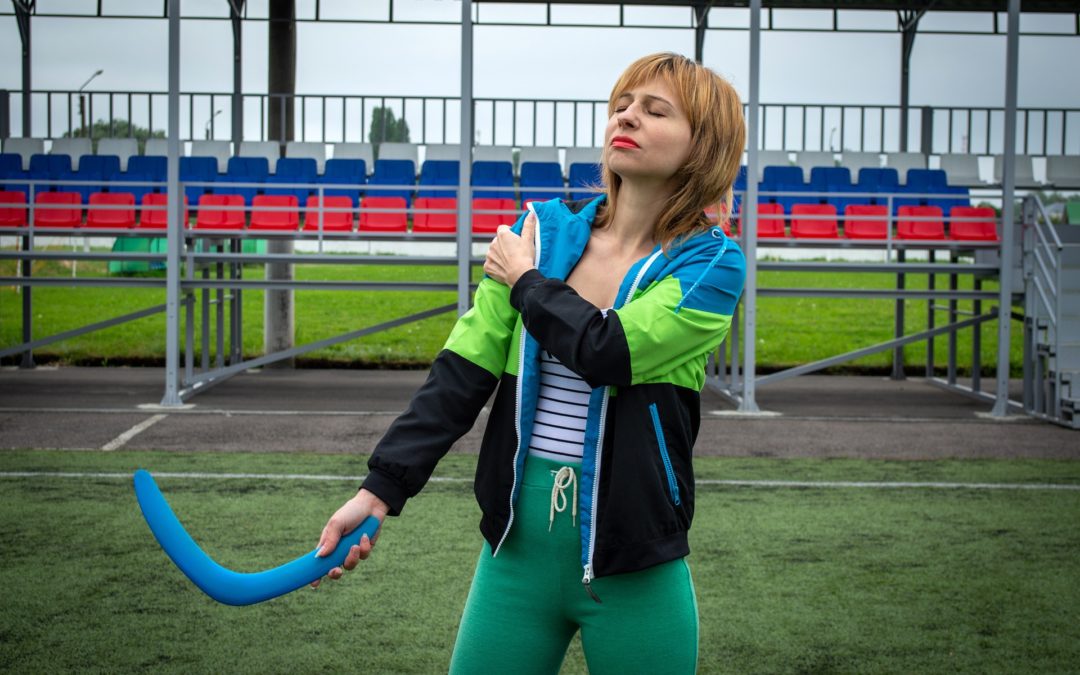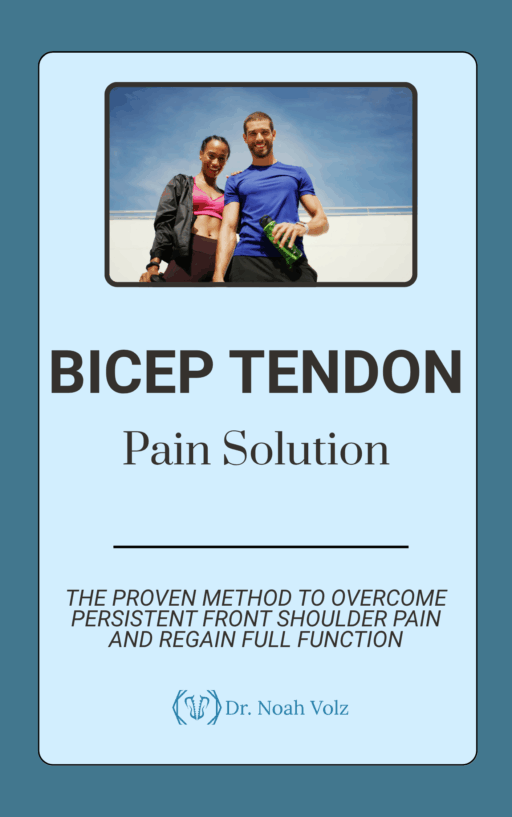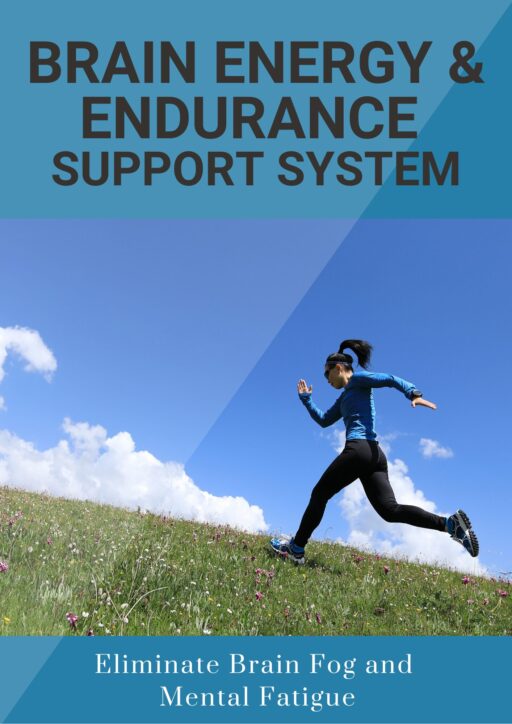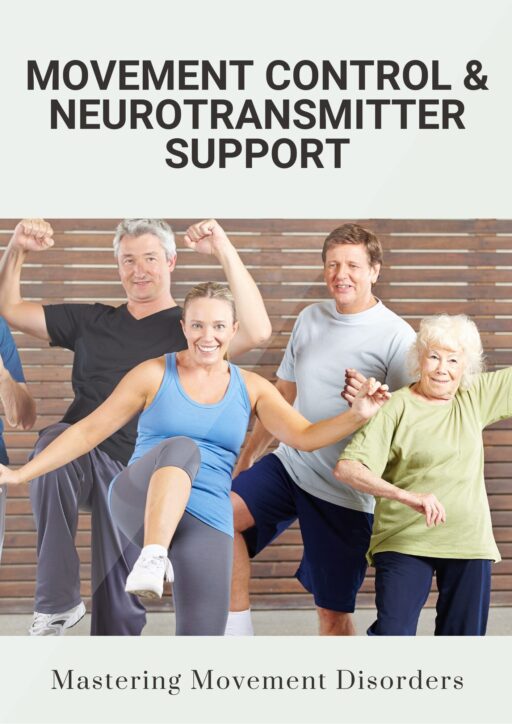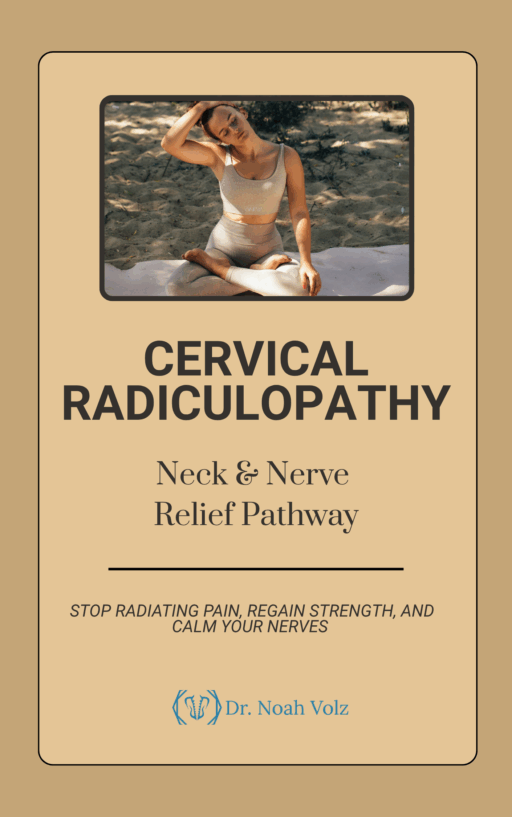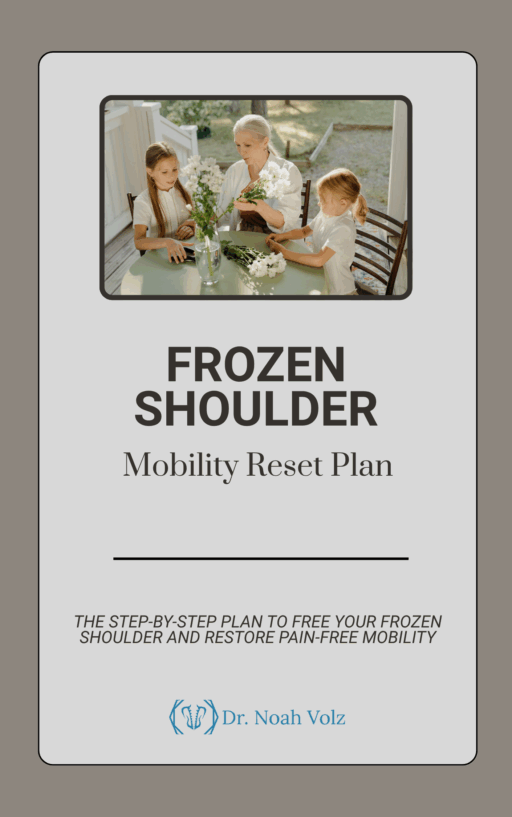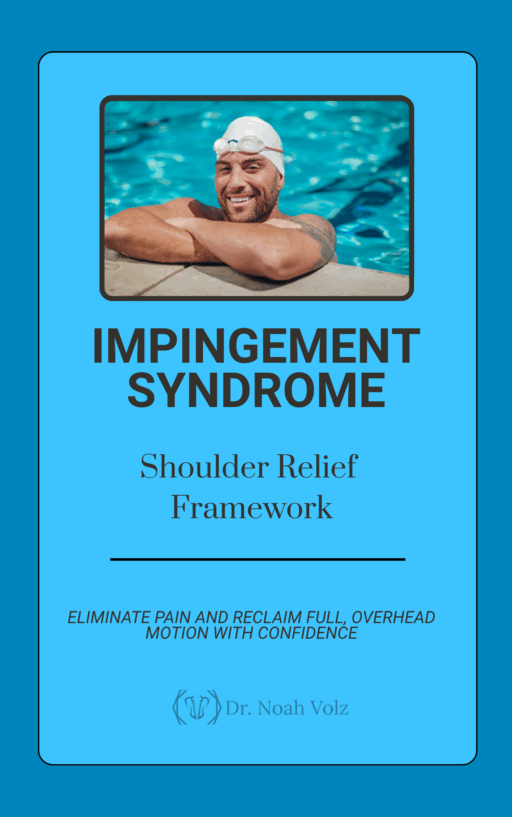Chances are that if you have shoulder pain it is from anterior impingement syndrome because it accounts for 44-65% of all shoulder complaints seen by physicians (1). The pain in the shoulder is from the supraspinatus tendon getting trapped between the acromion of the shoulder blade and the greater tuberosity of the humerus. It is considered a rotator cuff problem because the supraspinatus is one of the four rotator cuff muscles. (2)
Rotator cuff problems are common in younger and middle-aged individuals who perform repetitive overhead activities. It is most common in athletes who participate in: swimming, baseball, volleyball, weightlifting, and tennis. It is common in professions like carpenters, electricians, painters and wallpaper hangers.
Anterior impingement of the shoulder can go through three stages. Stage 1 is characterized by acute but reversible pain and swelling. It is common in younger patients.
Stage 2 typically affects middle aged patients who have had shoulder pain for months or years. Stage 2 is characterized by tendonitis and fibrosis of the supraspinatus tendon, biceps tendon and subacromial bursa. It may require surgical intervention.
Stage 3 is the result of prolonged irritation that has caused significant tendon degeneration and fibrosis. It typically affects patients over the age of 40 or 50 and is characterized by irreversible disruption of the rotator cuff tendon. There can also be degenerative changes of the bones of the shoulder. Bicep tendon degeneration and/or rupture can happen in stage 3. Surgical repair of the rotator cuff and acromioplasty are frequently required for the management of stage 3 anterior impingement of the shoulder. The rotator cuff has a couple primary jobs. It generates torque, especially when throwing. It is also a dynamic stabilizer of the glenohumeral joint. This stabilizing force from the rotator cuff offsets the movement of the arm bone from the larger deltoid muscle.
Once the rotator cuff isn’t working correctly it can get stuck in a self-perpetuating cycle of dysfunction. Repetitive movements damage the tendon, leading to tendon degeneration and weakening which diminishes the tendon’s ability to oppose the shearing force of the deltoid muscle that surrounds the shoulder capsule. This process leads to the tendon becoming impinged, leading to further injury. (3) As the tendon fibers fail, the remaining fibers are under extreme tension which increases the likelihood that they will fail. (4)
Causes of shoulder anterior impingement syndrome
The pain associated with shoulder anterior impingement syndrome is related to a period of overuse. The initial symptoms are sharp pain during overhead activity or while reaching behind the back to fasten a bra or close a zipper. If the symptoms are not addressed then the patient may develop a constant ache that is present at rest. Pain at night while sleeping is common and sleeping on the affected side will usually bring on symptoms. This is an indication that the rotator cuff tendon is staring to rupture. It is suggested that 95% of chronic rotator cuff tears are due to impingement.
The injury to the rotator cuff tendon is related to the available subacromial space. This space can be diminished by acromioclavicular joint degeneration, osteophytes, and a thickened coracoacromial ligament. The shape of the acromion can also lead to injury.
- 20% has a “Flat” (type I) acromion
- 55% has a “Curved” (type II)
- 25% has a “Beaked” (type III) acromion.
Type III causes rotator cuff tears in 75% of patients and this type is also more common in males. (5) In addition to the shape of the acromion, muscle tightness patterns called upper cross syndrome and poor movement of the shoulder blade called scapular dyskinesis leads to shoulder impingement.
Common symptoms of shoulder anterior impingement syndrome
The primary indicator or shoulder impingement is the location of the pain. Look for pain in the front and side of the shoulder. There may also be a decrease in range of motion and it may be challenging to lift the arm up and out and rotate the shoulder in and out. When raising the arm up out to the side it will be painful between 60-120 degrees. Another painful movement is to pull the arm across the body. Other painful movements are internal and external rotation. With the arm out to the side bend the elbow and then rotate internally and externally against resistance. There can be a loss of strength because of pain. Palpation of the shoulder will reveal pain on the front of the arm where the arm meets the shoulder. If you have one or more of these symptoms then it is likely that you have anterior shoulder impingement syndrome.
How to evaluate shoulder anterior impingement syndrome
Orthopedic tests are often used to determine if the pain you having in your shoulder is from anterior impingement. These tests are Neer test, Hawkins-Kennedy test, and Supraspinatus isolation/ “empty can” test.
Improper movement of the shoulder blade is a present in 100% of impingement cases. (6) Your chiropractor can use the scapular assistance test in order to raise up the acromion with movement of the arm to see if that reduces pain.
The test is performed while the patient brings their arm up and out to the side while the clinician pushes the inside and bottom of the shoulder blade up and out. Another functional test is called the Scapular retraction test, in this test the chiropractor pushed the bottom of the shoulder blade towards the spine while the patient brings the arm out to the side and up by the ear.
Relief of pain with either of these tests is an indication that the shoulder blade is not moving appropriately. (7)
Sometimes imaging can be helpful in the diagnosis of shoulder impingement. If there has been trauma, severe pain, prolonged pain or the inability to bring the arm out to the side at 90 degrees then X-rays are indicated. (8). Ultrasound can identify tendon disruptions, but MRI is useful to differentiate between findings shoulder impingement vs. rotator cuff tear. An MRI arthrogram enhances clinical accuracy by detecting tendon tears or labral injury (9).
Upper cervical chiropractic for shoulder anterior impingement syndrome
40-50% of primary care patients report unfavorable outcomes with shoulder pain. Management with upper cervical chiropractic must include restoring range of motion while avoiding aggravating movements. You should avoid overhead presses, lateral raises, and push-ups. Rest can be necessary at the beginning of the injury. In the early stages’ ultrasound, ice, low-level laser therapy, and NSAID’s can be helpful. (10,11,12)
While at the chiropractor the treatment will address the tight muscles with specific emphasis on the pec, biceps, subscapularis, infraspinatus, teres minor and levator. Adjustments of the shoulder, neck, upper back, and cervicothoracic spine will decrease shoulder pain while improving mobility and function. (13-16)
Therapeutic Tape applied across the supraspinatus, deltoid, and teres minor can help promote scapular movement, enhance strength, and speed recovery times. (17-19) Tape can also be used to increase subacromial space by applying it from insertion to origin over the deltoid and supraspinatus.
A stretching routine will be used to address tightness in the posterior capsule and internal rotators with emphasis on the: pec, biceps, subscapularis, infraspinatus, teres minor, and levator. Strengthening can be used as the patient’s pain-free range of motion allows. Begin with isometric exercises and progress as tolerated. Eccentric strengthening of the rotator cuff combined with eccentric/concentric exercises for the scapular stabilizers will produce improved outcomes. (20,21) The ultimate goal is to restore normal posture and joint movement.
Once ROM is full and pain-free, and strength testing reveals no significant weakness as compared to normal then athletes can return to play. Difficult cases may require steroid injections or surgical consult once adjustments, massage, and therapeutic exercise have been exhausted. Arthroscopic surgery of patients with subacromial shoulder pain is rarely helpful. (39)
Exercises to help heal shoulder anterior impingement syndrome
Conclusion
If impingement of the shoulder is a common part of your life and you are looking for an answer then I can help. I can help figure out what the cause of the shoulder pain is. Use chiropractic adjustments and massage to get you out of pain and teach you the exercises you will need in order to build a resilient shoulder that is immune to pain. If you are ready to try this approach schedule with me today. Still looking for more information? Check out my eBook on Chronic Neck Pain.
References
- Van der Windt, D.A., Koes, B.W., De Jong, B.A., Bouter, L.M., Shoulder disorders in general practice: incidence, patient characteristics, and management. Ann. Rheum. Dis. 1995, 54, 959–964.
- Neer CE III. Impingement lesions. Clin Orthop. 1983;173:70–77.
- Budoff EF, Rodin D, Ochiai D, Nirschl RP. Arthroscopic Rotator Cuff Debridement Without Decompression for the Treatment of Tendinosis. Arthroscopy: The Journal of Arthroscopic and Related Surgery. 2005;21:1081–1089
- Vai AG, Cupis MD, et al. Clinical and Biological Aspects of Rotator Cuff Tears. Muscles Ligaments Tendons J. 2013 February 24; 3(4): 359.
- Alqunaee M, Galvin R, Fahey T. Diagnostic accuracy of clinical tests for subacromial impingement syndrome: a systematic review and meta-analysis. Arch Phys Med Rehabil. Feb 2012;93(2):229-36. Thomas R, Berquist HMRI of the Musculoskeletal System 6th edition 2012, by Lippincott Williams & Wilkins
- Warner J.J.P, Micheli L.J, Arslanian L.E, Kennedy J, Kennedy R. Scapulothoracic motion in normal shoulders and shoulders with glenohumeral instability and impingement syndrome. Clin Orthop Rel Res. 1992;285:191–199.
- Kibler WB, Sciascia AD, Dome DC. Evaluation of apparent and absolute supraspinatus strength in patients with shoulder injury using the scapular retraction test. Am J Sports Med 2006;34:1643–7.
- Srevenson J.H., Trojian T. Evaluation of Shoulder Pain. The Journal of Family Practice July 2002, Vol. 51(7).
- Flannigan B, Kursunoglu-Brahme S. Karzel R MR Arthrography Of the Shoulder: Comparison with conventional MR Imaging. American Journal of Roentgenology October 1990, 155(4) 829-832.
- Yu H, Cote P, Shearer HM, Wong JJ, Sutton DA, Randhawa KA, Varatharajan S, Southerst D, Mior SA, Ameis A, Stupar M, Nordin M, van der Velde GM, Carroll L, Jacobs CL, Taylor-Vaisey AL, Abdulla S, Shergill Y. Effectiveness of passive physical modalities for shoulder pain: systematic review by the Ontario protocol for traffic injury management collaboration. Phys Ther. 2015 Mar;95(3):306-18.
- Hawk C. Systematic Review of Nondrug, Nonsurgical Treatment of Shoulder Conditions. J Manipulative Physiol Ther 2017 Jun ;40(5):293-319
- Gomes, Cid André Fidelis de Paula et al. Effect of Adding Interferential Current in an Exercise and Manual Therapy Program for Patients With Unilateral Shoulder Impingement Syndrome: A Randomized Clinical Trial Journal of Manipulative & Physiological Therapeutics , Volume 41 , Issue 3 , 218 – 226
- Crosbie J, Kilbreathe SL, Hooman L, York S. Scapulohumeral rhythm and associated spinal motion. Clin Biomechan. 2008; 23: 184-192.
- Strunce JB, et al. The Immediate Effects of Thoracic Spine and Rib Manipulation on Subjects with Primary Complaints of Shoulder Pain J Man Manip Ther. 2009; 17(4): 230–236.
- Walser RF, Meseve BB, Boucher TR. The Effectiveness of Thoracic Spine Manipulation for the Management of Musculoskeletal Conditions: A Systematice Review and Meta-Analysis of Randomized Controlled Trials. J Man Manip Ther. 2009; 17(4): 237-246.
- Muth S et al. The Effects of Thoracic Spine Manipulation in Subjects With Signs of Rotator Cuff Tendinopathy Journal of Orthopaedic & Sports Physical Therapy, 2012, Volume: 42 Issue: 12 Pages: 1005-1016
- Hsu Y, Chen W, et al. The effects of taping on scapular kinematics and muscle performance in baseball players with shoulder impingement syndrome. Journal of Electromyography and Kinesiology 2009;19:1092-1099
- Kaya E, Zinnuroglu M, Tugcu I. Kinesio taping compared to physical therapy modalities for the treatment of shoulder impingement syndrome. Clincial Rheumatology 2010;30(2):201-207
- Thelen M, Dauber J, Stoneman P. The Clinical Efficacy of Kinesio Tape for shoulder Pain: A Randomized Double-blinded, Clinical Trial. Journal of Orthopaedic & Sports Physical Therapy 2008;38(7):389-395
- Holmgren T, Bjornsson Hallgren H, Oberg B et al. Effect of specific exercise strategy on need for surgery in patients with subacromial impingement syndrome: randomised controlled study. BMJ. 2012 Feb 20;344:e787.
- Bernhardsson S, Klintberg IH, Wendt GK. Evaluation of an exercise concept focusing on eccentric strength training of the rotator cuff for patients with subacromial impingement syndrome. Clin Rehabil. Jan 2011;25(1):69-78.
-

Bicep Tendon Pain Solution
$50.00 -

Brain Detoxification & Recovery System
$50.00 -

Brain Energy and Endurance Support System
$50.00 -

Brain-Based Movement and Motor Control Training
$50.00 -

Centralized Low Back Pain
$50.00 -

Cervical Radiculopathy: Neck and Nerve Relief Pathway
$50.00 -

Complex Low Back Pain
$50.00 -

Complex Radiating Low Back Pain
$50.00 -

Cross-Pattern Low Back Pain
$50.00 -

Frozen Shoulder Mobility Reset Plan
$50.00 -

Impingement Syndrome: Shoulder Relief Framework
$50.00 -

Mastering Brain Senses: Rebuild Your Hearing, Vision, and Body Awareness
$50.00

